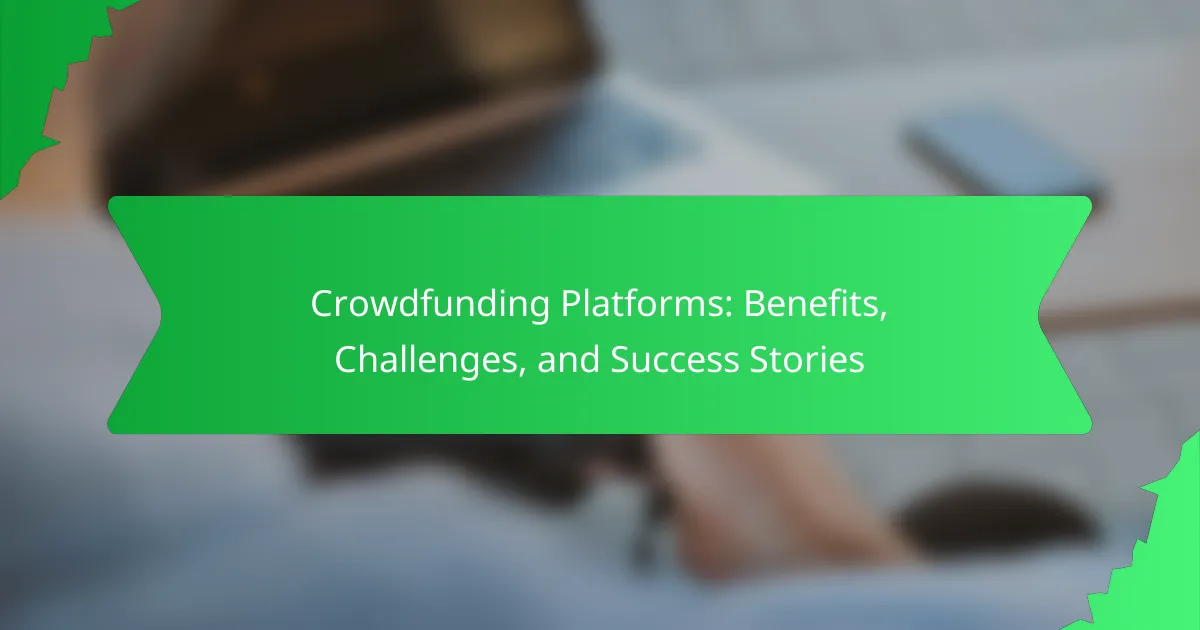Crowdfunding platforms are online services that allow individuals and organizations to raise funds from a large number of contributors. This article explores the benefits and challenges of using crowdfunding platforms, highlighting how they enable the collection of small contributions to support various projects, businesses, and causes. It also presents success stories from notable platforms such as Kickstarter and Indiegogo, along with insights into the fees associated with these services. Additionally, the article examines the significant growth of the global crowdfunding market, valued at approximately $13.9 billion in 2021, underscoring the increasing importance of crowdfunding in financing diverse initiatives.

What are Crowdfunding Platforms?
Crowdfunding platforms are online services that enable individuals or organizations to raise funds from a large number of people. These platforms facilitate the collection of small amounts of money from many contributors to support projects, businesses, or causes. Popular crowdfunding platforms include Kickstarter and Indiegogo. They typically charge a fee based on the funds raised. According to a report by Statista, the global crowdfunding market was valued at approximately $13.9 billion in 2021. This demonstrates the growing significance of crowdfunding in financing various initiatives.
How do Crowdfunding Platforms operate?
Crowdfunding platforms operate by connecting project creators with potential backers. These platforms facilitate the funding process for various projects, products, or causes. Creators present their ideas through detailed campaigns, often including videos and descriptions. Backers can contribute funds in exchange for rewards or equity. The platforms typically charge fees based on the total funds raised. Successful campaigns often reach their funding goals within a set timeframe. According to Statista, the crowdfunding market was valued at approximately $13.9 billion in 2021, highlighting its growing importance.
What are the key features of Crowdfunding Platforms?
Crowdfunding platforms facilitate the raising of funds from a large number of people. Key features include project listing, where creators present their ideas to potential backers. They often provide tiered rewards for different funding levels. Payment processing is another critical feature, enabling secure transactions. Community engagement tools allow interaction between creators and backers. Analytics dashboards help creators track funding progress and backer engagement. Social media integration enhances project visibility. Lastly, many platforms offer support resources for creators to improve project success.
What types of crowdfunding models exist?
There are several types of crowdfunding models. The main models include donation-based, reward-based, equity-based, and debt-based crowdfunding.
Donation-based crowdfunding allows individuals to contribute without expecting anything in return. This model is often used for charitable causes and community projects.
Reward-based crowdfunding offers backers tangible rewards or perks in exchange for their contributions. This is commonly seen in creative projects like art, music, and technology.
Equity-based crowdfunding enables investors to purchase shares in a company. This model is regulated and allows businesses to raise capital from a larger pool of investors.
Debt-based crowdfunding, also known as peer-to-peer lending, involves individuals lending money to businesses or individuals with the expectation of repayment with interest.
Each model serves different purposes and appeals to various types of projects and investors.
What are the benefits of using Crowdfunding Platforms?
Crowdfunding platforms offer several benefits for individuals and businesses seeking funding. They provide access to a large pool of potential investors. This democratizes fundraising by allowing anyone to contribute. Crowdfunding can validate business ideas through community support. Successful campaigns often attract media attention, increasing visibility. Platforms typically charge lower fees compared to traditional funding methods. They also enable direct engagement with backers, fostering a loyal customer base. According to a study by the University of Cambridge, crowdfunding has raised over $34 billion globally in 2020, highlighting its growing importance in finance.
How can Crowdfunding Platforms help startups?
Crowdfunding platforms can help startups by providing access to capital. They allow entrepreneurs to raise funds from a large number of people, often through small contributions. This method reduces reliance on traditional financing options like banks or venture capitalists. Startups can showcase their ideas and products to a broad audience. Successful campaigns can create a community of early adopters and brand advocates. According to Statista, crowdfunding generated over $34 billion globally in 2020. This growth indicates a strong interest in supporting new business ventures. Additionally, crowdfunding platforms often offer marketing exposure, helping startups reach potential customers.
What financial advantages do Crowdfunding Platforms offer?
Crowdfunding platforms offer several financial advantages. They provide access to capital without traditional loan requirements. This reduces barriers for startups and small businesses. Crowdfunding can also validate business ideas through public interest. Successful campaigns can generate significant funds quickly. According to Statista, the global crowdfunding market reached over $10 billion in 2020. Additionally, platforms often charge lower fees than banks. This makes it a cost-effective option for fundraising. Lastly, crowdfunding can lead to customer acquisition and brand loyalty.
What challenges do Crowdfunding Platforms face?
Crowdfunding platforms face several challenges that hinder their effectiveness. One major challenge is regulatory compliance. Many countries have strict laws governing fundraising activities, which can complicate operations. Additionally, fraud and scams pose significant risks to both platforms and backers. Instances of failed projects or mismanagement can lead to distrust among users.
Another challenge is competition among platforms. The increasing number of crowdfunding sites makes it difficult to attract and retain users. Platforms must continuously innovate to stand out. Furthermore, marketing and user acquisition can be costly. High advertising expenses may impact profitability.
Lastly, ensuring project quality is vital. Platforms struggle to maintain a standard for projects, which can affect their reputation. Without proper vetting, low-quality projects may deter potential investors. These challenges collectively impact the growth and sustainability of crowdfunding platforms.
What are common risks associated with Crowdfunding Platforms?
Common risks associated with crowdfunding platforms include project failure, fraud, and lack of regulation. Project failure occurs when a campaign does not meet its funding goals or deliver on promises. According to a study by the University of Cambridge, about 70% of crowdfunding projects fail to deliver rewards to backers. Fraud can happen if creators misrepresent their projects or intentions. The lack of regulation in many regions makes it difficult to protect backers from scams. Additionally, backers may experience financial loss if the project does not succeed. The potential for loss is significant, as a survey by the crowdfunding platform Indiegogo revealed that 40% of backers reported losing money on failed campaigns.
How can project creators overcome obstacles in Crowdfunding?
Project creators can overcome obstacles in crowdfunding by developing a clear strategy. This includes setting realistic funding goals and timelines. Engaging with potential backers early can build a supportive community. Transparent communication about project progress is crucial. Utilizing social media for promotion can increase visibility and reach. Offering attractive rewards incentivizes contributions. Collaborating with influencers can expand the project’s audience. Research shows that campaigns with strong social engagement raise 50% more funds on average.
How do Crowdfunding Platforms impact communities?
Crowdfunding platforms positively impact communities by facilitating access to financial resources. They enable individuals and groups to raise funds for projects that benefit local areas. This funding can support startups, social initiatives, and community services. According to a study by the University of Cambridge, crowdfunding has led to the creation of over 1.4 million jobs in the U.S. alone. Additionally, these platforms foster community engagement and collaboration. They encourage people to contribute to causes they care about, strengthening social ties. Overall, crowdfunding platforms enhance community development and empower individuals to take action.
What are some notable success stories from Crowdfunding Platforms?
Some notable success stories from crowdfunding platforms include the Pebble Smartwatch and the Oculus Rift. Pebble raised over $10 million on Kickstarter in 2012. It became one of the first successful smartwatches, leading to significant market influence. Oculus Rift, a virtual reality headset, raised nearly $2.5 million on Kickstarter in 2012. It was later acquired by Facebook for $2 billion, revolutionizing the gaming industry. Another success is the Exploding Kittens card game, which raised over $8.7 million on Kickstarter in 2015. This game became one of the most backed projects in Kickstarter history. These examples illustrate the potential of crowdfunding to launch innovative products and ideas.
What factors contributed to the success of these campaigns?
Successful crowdfunding campaigns often rely on several key factors. First, a compelling story engages potential backers. This emotional connection encourages support and investment. Second, effective marketing strategies amplify campaign visibility. Utilizing social media and email marketing can reach a broader audience. Third, a well-defined target audience ensures that campaigns resonate with the right people. Tailoring messages to specific demographics increases the likelihood of funding. Fourth, offering attractive rewards motivates backers to contribute. Unique and valuable incentives can enhance participation. Fifth, transparent communication builds trust with supporters. Regular updates keep backers informed and invested in the project. Lastly, leveraging existing networks can significantly boost campaign success. Engaging friends, family, and professional contacts can create initial momentum. These factors collectively contribute to the overall success of crowdfunding campaigns.
How do these success stories inspire new projects?
Success stories inspire new projects by demonstrating achievable outcomes. They provide real-world examples of how ideas can be successfully funded and developed. These narratives often highlight innovative solutions and strategies that resonate with potential creators. Seeing tangible results encourages others to pursue their own projects. Success stories also create a sense of community, motivating individuals to contribute to similar initiatives. Furthermore, they can attract investors by showcasing a proven track record. For instance, platforms like Kickstarter have numerous documented cases where projects exceeded funding goals, reinforcing the viability of new ventures. This evidence fosters confidence among aspiring entrepreneurs, leading to increased participation in crowdfunding.
What are best practices for launching a campaign on Crowdfunding Platforms?
Best practices for launching a campaign on crowdfunding platforms include thorough planning, engaging storytelling, and effective marketing strategies. Start by defining clear goals and target funding amounts. Create a compelling narrative that connects emotionally with potential backers. Use high-quality visuals and videos to enhance your message. Build a community prior to launch through social media and email outreach. Set realistic timelines for your campaign duration. Offer attractive rewards that incentivize contributions. Finally, maintain communication with backers throughout the campaign to keep them engaged and informed. These practices significantly increase the likelihood of campaign success, as evidenced by successful campaigns achieving their funding goals through effective engagement and planning.
Crowdfunding platforms are online services that enable individuals and organizations to raise funds from a large number of contributors for various projects, businesses, or causes. This article explores the operation of these platforms, their key features, and the different types of crowdfunding models, such as donation-based and equity-based crowdfunding. Additionally, it examines the benefits and challenges associated with crowdfunding, including regulatory compliance and project quality, while highlighting notable success stories that demonstrate the potential impact of crowdfunding on startups and communities. Best practices for launching successful campaigns are also provided, offering insights into effective strategies for project creators.
